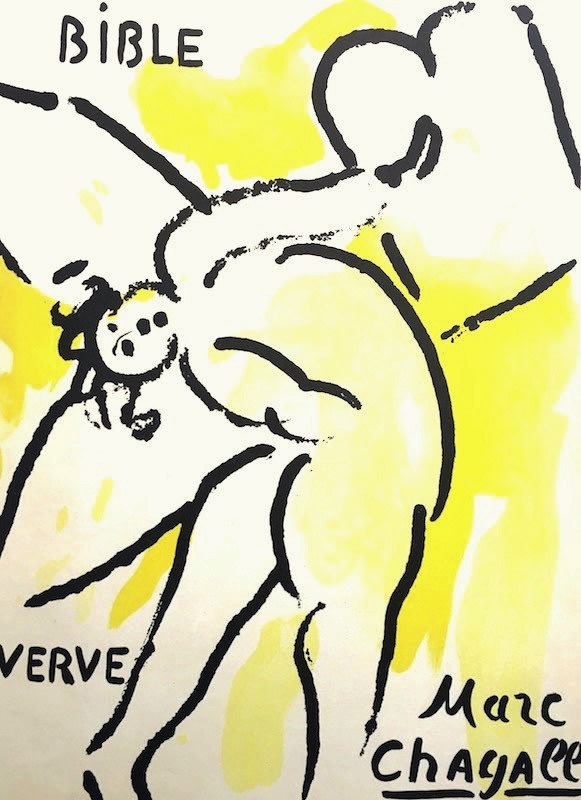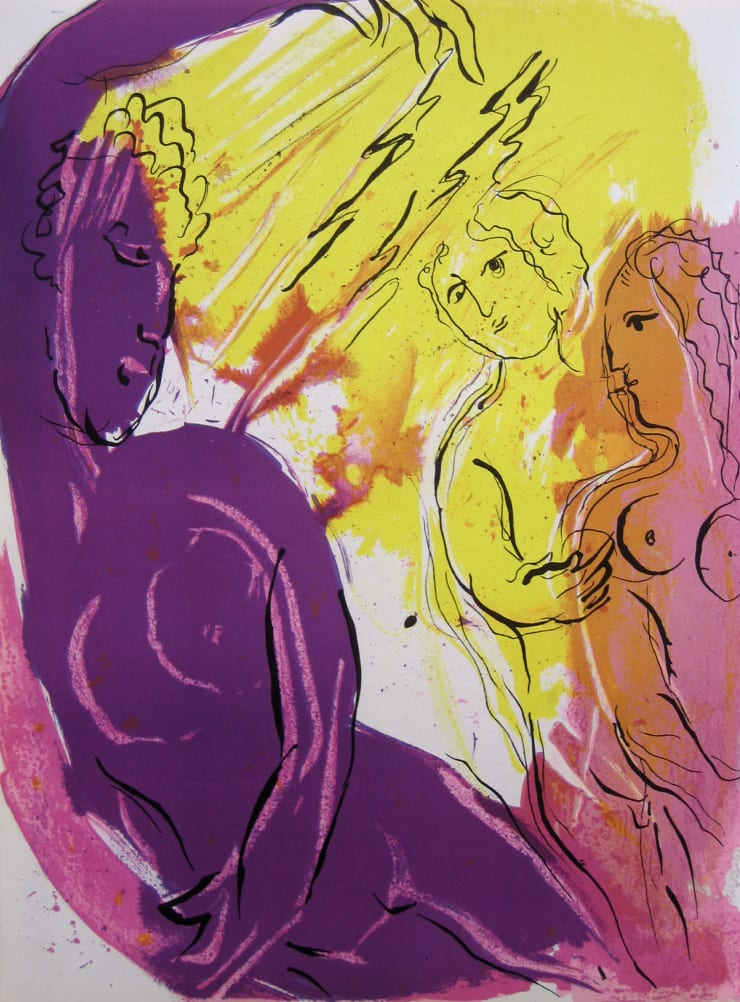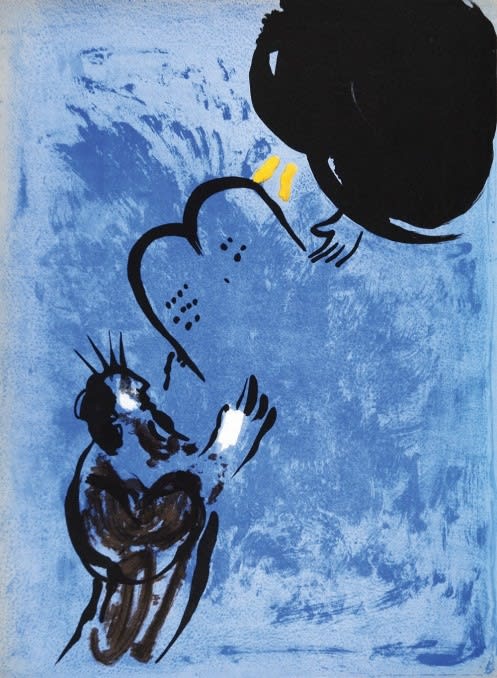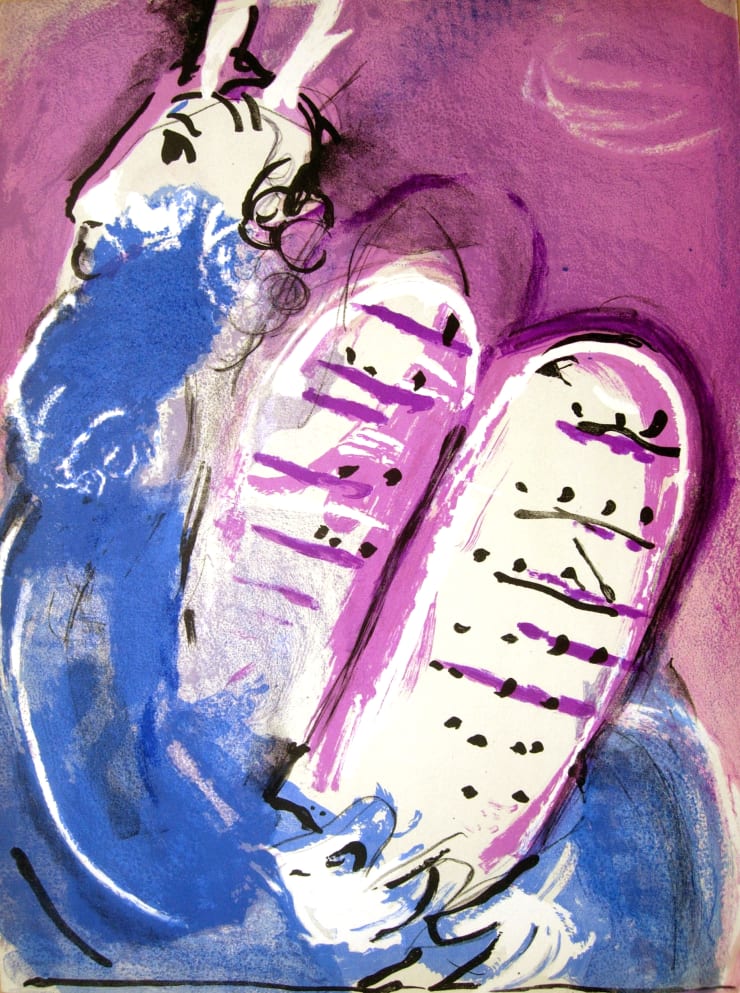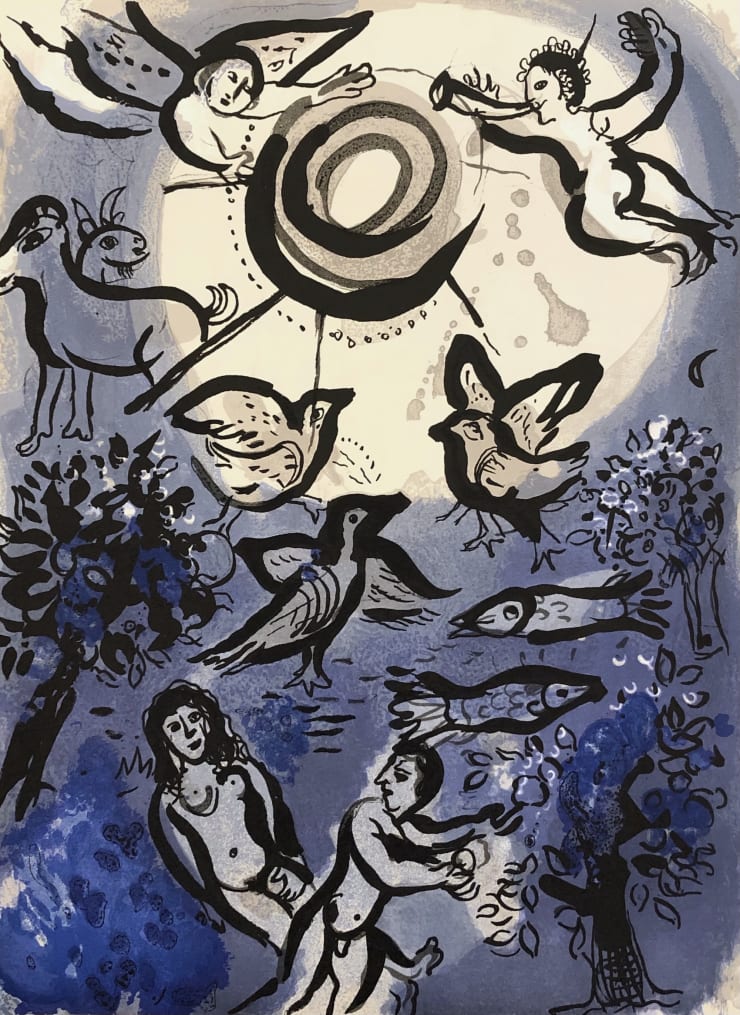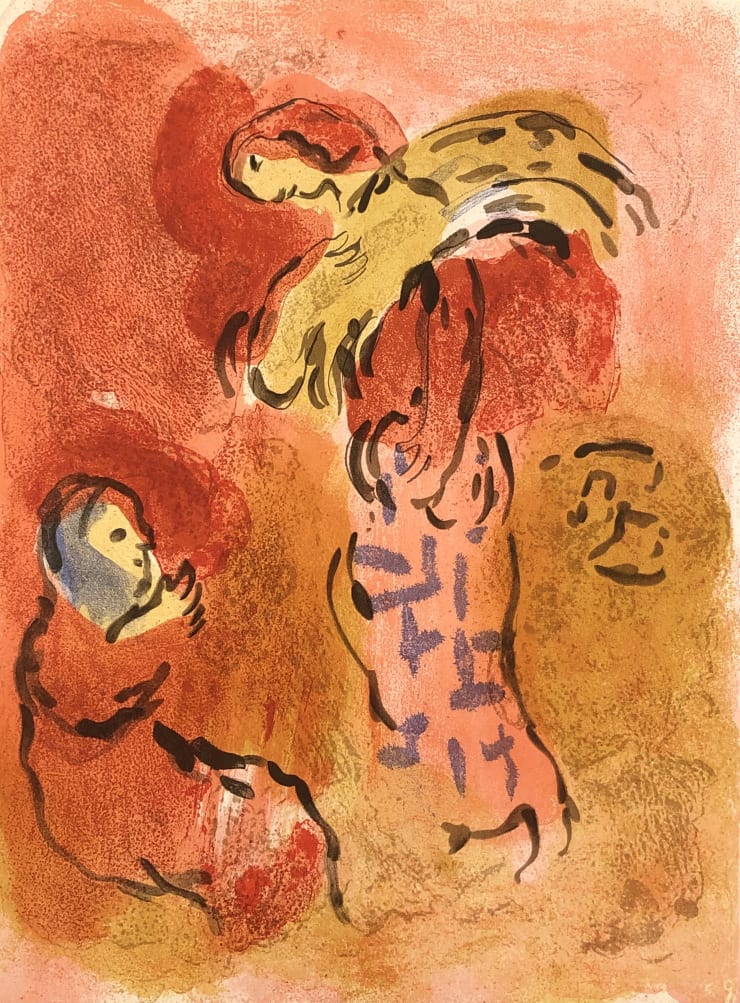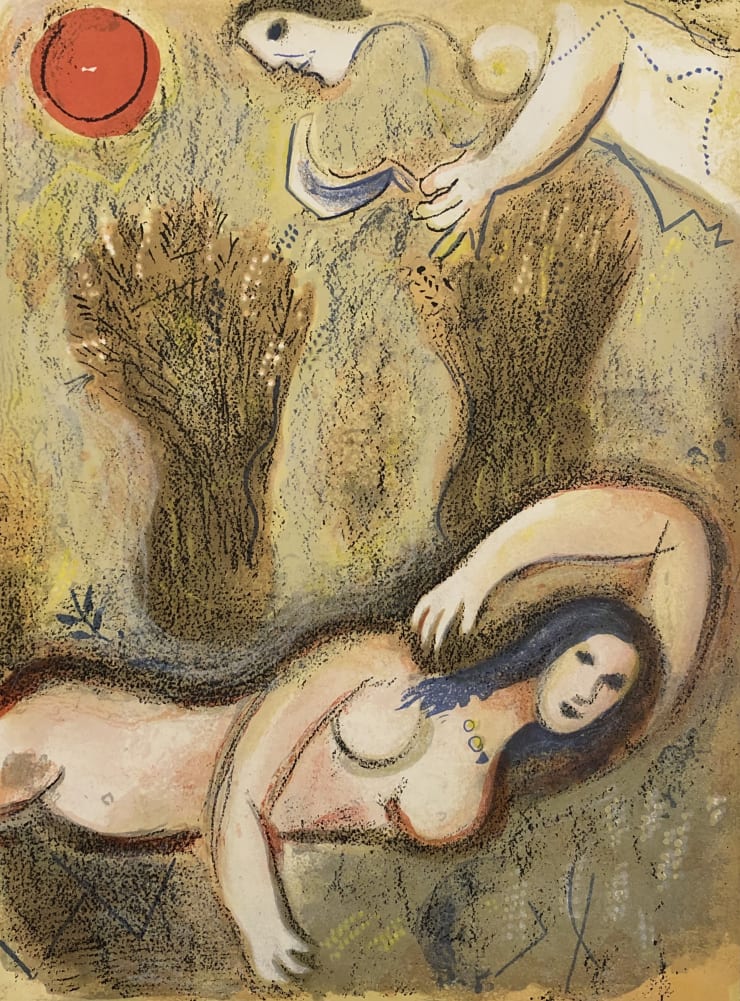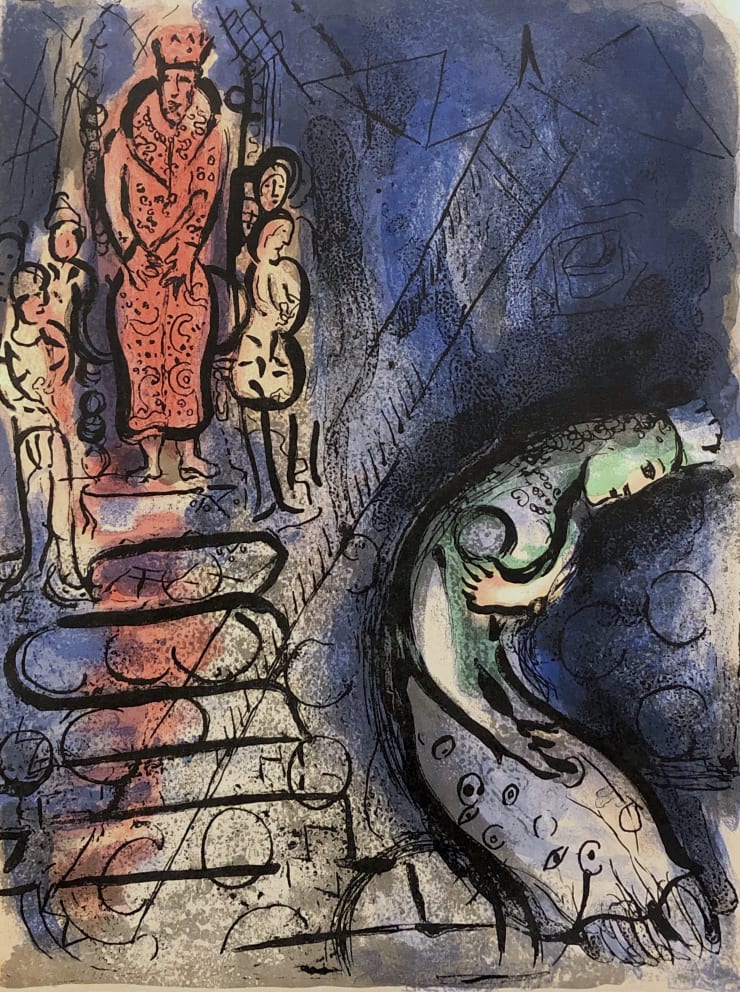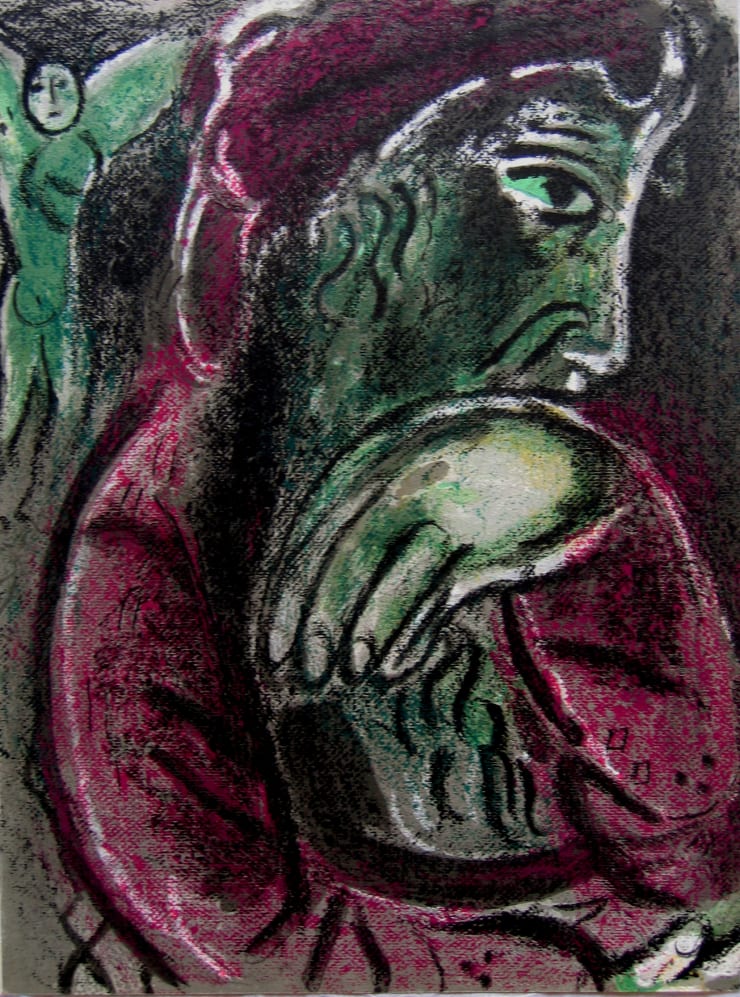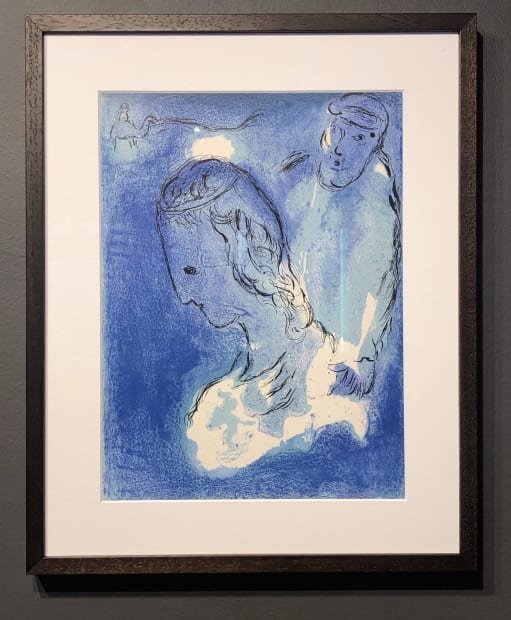‘Ever since my earliest youth,’ Chagall wrote, ‘I have been fascinated with the Bible. I have always believed that it is the greatest source of poetry of all time. I have sought its reflection in life and art. The Bible is life, an echo of nature, and this is the secret I have endeavoured to transmit.’
As mystical as these words may sound to us now, and indeed, to his modernist contemporaries, when we look at the 40 Bible lithographs, resplendent and humane, full of awe and pathos, it is hard not to feel that Chagall succeeded in his endeavour. His deep preoccupation with the spiritual life is borne out by a great many paintings, prints and stained-glass windows. Yet, if all of these were lost, his Bible lithographs alone would confirm him as the greatest religious artist since William Blake.
Bible stories sustained Chagall over three tumultuous decades marked by World War, his exile from France and the death of his wife. The origin of these Bible lithographs reaches back to a 1931 commission from influential dealer Ambroise Vollard for a series of etchings depicting scenes from the Bible.
-
In preparation, Chagall undertook his first pilgrimage to the Holy Land, a trip which bestowed upon him ‘the most vivid impression’ he had ever received, as well as a visit to Amsterdam, to view El Greco and Rembrandt. In 1948, publisher Antoine Tériade commissioned a set of lithographs for his art review Verve for which Chagall created 16 original colour lithographs. Verve Vol. VIII entitled The Bible was published in France and America in 1956. Four years later, Chagall and Tériade devoted another issue of Verve to Bible illustrations. Entitled Dessins pour la Bible (Drawings for the Bible), Verve Vol. X was published in 1960 and featured 24 original lithographs. Together, these two issues comprise the full set of 40 lithographs, as illustrated in this catalogue.
Chagall’s Bible lithographs are an exemplar of one of the most celebrated qualities of his art: colour. ‘When Matisse dies,’ an uncharacteristically generous Picasso remarked, ‘Chagall will be the only painter left who understands what colour really is.’ The intensity of the palette transforms the work; each piece is charged with a depth of feeling that can only be understood by examining the contradictions that stood at the heart of Chagall. Born in a peripheral city of Imperial Russia, he fell in love with France, where he was, in a sense, born again, as an artist, yet he never turned his back on his place of birth, the imagery of which returns again and again in his work. He was the eldest son of devout Hasidic Jews but embraced the image of Christ and the Crucifixion, maintaining a personal connection to God while adhering to no religion in the strictest sense. On his journey to Palestine he was, like his contemporaries, looking abroad for inspiration, yet what he found there was not a jolting confrontation with the Other, but a belonging, a powerful connection to the land of his ancestors.
‘Whenever I bent over the lithography stone it was as though I was touching a talisman. It seemed as though I could pour all my sadness and joys into it.’
Chagall had run the gamut of the 20th century’s diverse art movements, and his mastery of them is evident in the Bible lithographs. However, there is none of the distance and detachment that characterise so much of modernist art, no irony (though there is, at times, humour). He has, of course, completely eschewed the severe realism of the most familiar Biblical art, that of the Renaissance, but in some sense, his work is more accurate, in that he is not portraying his ancient subjects as ostensibly European Christians in contemporary attire.
He differs further from much of traditional religious art in his foregrounding of women and animals. There are numerous prints dedicated to the most familiar stories, such as Genesis and Exodus: an ethereal, luminous Creation, a blood red, violent Cain and Abel. But here, too, is Sarah receiving God’s blessing from three mirthful angels, and Hagar, children gathered in the crook of her arm, despairing in the desert. Five prints – one eighth of the body of work – are given over to the story of Ruth. Here, so crucial to Chagall and so often lacking in other religious works, is compassion. We see it in the face of the donkey in Jeremiah, a simple depiction of an animal, but one which imbues the creature with a poignant individuality. Through strength of feeling, Chagall has succeeded in sublimating his internal contradictions, has met the ancient with his modernist sensibilities to produce works that make those stories with which we are all most familiar seem strange to us, while at the same time giving them an emotional immediacy which makes the transcendental nature of the stories highly personal.
- Luke Wallis, January 2022
We have also created a beautiful catalogue for the exhibition which can be viewed and purchased HERE.
-
Vincent Eames and Ardyn Halter discuss Chagall's work and our current exhibition 'Bible Stories' in the Print Room
Click HERE to view the film
-
1956
-
 Marc ChagallBible (Title Page), 1956£850.00
Marc ChagallBible (Title Page), 1956£850.00 -
 Marc ChagallAngel with sword, 1956£850.00
Marc ChagallAngel with sword, 1956£850.00 -
 Marc ChagallAngel, 1956£850.00
Marc ChagallAngel, 1956£850.00 -
 Marc ChagallAngel of Paradise , 1956Sold
Marc ChagallAngel of Paradise , 1956Sold -
 Marc ChagallAbraham and Sarah, 1956£850.00
Marc ChagallAbraham and Sarah, 1956£850.00 -
 Marc ChagallMoses receives the Tablets of the Law , 1956Sold
Marc ChagallMoses receives the Tablets of the Law , 1956Sold -
 Marc ChagallMoses with the Tablets of the Law (I), 1956Sold
Marc ChagallMoses with the Tablets of the Law (I), 1956Sold -
 Marc ChagallMoses with the Tablets of the Law (II), 1956Sold
Marc ChagallMoses with the Tablets of the Law (II), 1956Sold -
 Marc ChagallMoses with the Tablets of the Law (III), 1956Sold
Marc ChagallMoses with the Tablets of the Law (III), 1956Sold -
 Marc ChagallSolomon, 1956Sold
Marc ChagallSolomon, 1956Sold -
 Marc ChagallDavid with his harp, 1956Sold
Marc ChagallDavid with his harp, 1956Sold -
 Marc ChagallDavid mourning Absalom, 1956£850.00
Marc ChagallDavid mourning Absalom, 1956£850.00 -
 Marc ChagallDavid and Bathsheba, 1956Sold
Marc ChagallDavid and Bathsheba, 1956Sold -
 Marc ChagallJeremiah, 1956Sold
Marc ChagallJeremiah, 1956Sold -
 Marc ChagallIsaiah, 1956£850.00
Marc ChagallIsaiah, 1956£850.00 -
 Marc ChagallDaniel, 1956£850.00
Marc ChagallDaniel, 1956£850.00 -
 Marc ChagallLamentations of Jeremiah, 1956£850.00
Marc ChagallLamentations of Jeremiah, 1956£850.00
-
-
1960
-
 Marc ChagallThe Maid of Israel, 1960£850.00
Marc ChagallThe Maid of Israel, 1960£850.00 -
 Marc ChagallThe Garden of Eden (I), 1960Sold
Marc ChagallThe Garden of Eden (I), 1960Sold -
 Marc ChagallThe Garden of Eden (II) , 1960Sold
Marc ChagallThe Garden of Eden (II) , 1960Sold -
 Marc ChagallCreation, 1960Sold
Marc ChagallCreation, 1960Sold -
 Marc ChagallAdam and Eve and the Forbidden Fruit, 1960Sold
Marc ChagallAdam and Eve and the Forbidden Fruit, 1960Sold -
 Marc ChagallGod rebukes Eve, 1960Sold
Marc ChagallGod rebukes Eve, 1960Sold -
 Marc ChagallAdam and Eve are banished from the Garden of Eden, 1960Sold
Marc ChagallAdam and Eve are banished from the Garden of Eden, 1960Sold -
 Marc ChagallCain and Abel, 1960£850.00
Marc ChagallCain and Abel, 1960£850.00 -
 Marc ChagallSarah and Abimelech, 1960£850.00
Marc ChagallSarah and Abimelech, 1960£850.00 -
 Marc ChagallSarah and the Angels, 1960£850.00
Marc ChagallSarah and the Angels, 1960£850.00 -
 Marc ChagallHagar in the Desert, 1960£850.00
Marc ChagallHagar in the Desert, 1960£850.00 -
 Marc ChagallRachel steals her father's graven images, 1960£850.00
Marc ChagallRachel steals her father's graven images, 1960£850.00 -
 Marc ChagallTamar, the daughter in law of Judah, 1960£850.00
Marc ChagallTamar, the daughter in law of Judah, 1960£850.00 -
 Marc ChagallRahab and the spies of Jericho, 1960£850.00
Marc ChagallRahab and the spies of Jericho, 1960£850.00 -
 Marc ChagallNaomi and her daughters in law, 1960£850.00
Marc ChagallNaomi and her daughters in law, 1960£850.00 -
 Marc ChagallRuth, the gleaner, 1960Sold
Marc ChagallRuth, the gleaner, 1960Sold -
 Marc ChagallThe Meeting of Ruth and Boaz, 1960£850.00
Marc ChagallThe Meeting of Ruth and Boaz, 1960£850.00 -
 Marc ChagallRuth at the Feet of Boaz, 1960£850.00
Marc ChagallRuth at the Feet of Boaz, 1960£850.00 -
 Marc ChagallBoaz wakes up and sees Ruth at his feet, 1960Sold
Marc ChagallBoaz wakes up and sees Ruth at his feet, 1960Sold -
 Marc ChagallDavid saved by Michal, 1960Sold
Marc ChagallDavid saved by Michal, 1960Sold -
 Marc ChagallAhasuerus banishes Vashti, 1960Sold
Marc ChagallAhasuerus banishes Vashti, 1960Sold -
 Marc ChagallEsther, 1960Sold
Marc ChagallEsther, 1960Sold -
 Marc ChagallJob at prayer, 1960£850.00
Marc ChagallJob at prayer, 1960£850.00 -
 Marc ChagallJob disconsolate, 1960Sold
Marc ChagallJob disconsolate, 1960Sold
-
-


